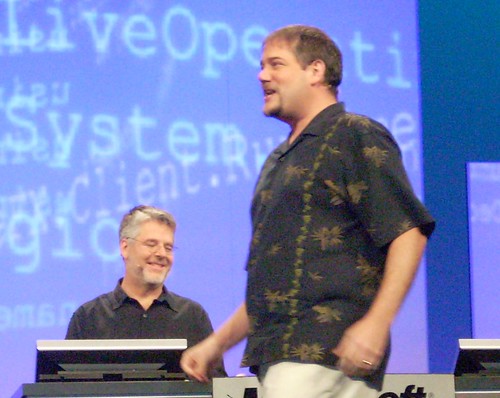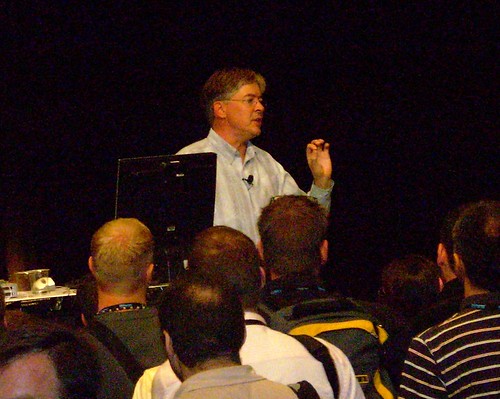Tag: cloud
SoCalCodeCamp Slide Decks
Posted by bsstahl on 2018-11-10 and Filed Under: event
The slide decks for my two talks at SoCalCodeCamp USC from November 10, 2018 are below.
- Intro to WebAssembly Using Blazor – SGM-124 at 1:30 pm
- Building .NET Applications for any Cloud with Cloud Foundry – GFS-207 at 4:00 pm
Thanks to all of the organizers and attendees of this always amazing event.
Tags: blazor cloud cloud foundry code camp community conference open source presentation slides speaking wasm webassembly
A Requirement for AI Systems
Posted by bsstahl on 2017-05-24 and Filed Under: development
I've written and spoken before about the importance of using the Strategy Pattern to create maintainable and testable systems. Strategies are even more important, almost to the level of necessity, when building AI systems.
The Strategy Pattern is to algorithms what the Repository Pattern is to data stores, a useful and well-known abstraction for loose-coupling. — Barry Stahl (@bsstahl) January 6, 2017
The Strategy Pattern is an abstraction tool used to maintain loose-coupling between an application and the algorithm(s) that it uses to do its job. Since the algorithms used in AI systems have many different ways they could be implemented, it is important to abstract the implementation from the system that uses it. I tend to work with systems that use combinatorial optimization methods to solve their problems, but there are many ways for AIs to make decisions. Machine Learning is one of the hottest methods right now but AI systems can also depend on tried-and-true object-oriented logic. The ability to swap algorithms without changing the underlying system allows us the flexibility to try multiple methods before settling on a specific implementation, or even to switch-out implementations as scenarios or situations change.
When I give conference talks on building AI Systems using optimization methods, I always encourage the attendees to create a "naïve" solution first, before spending a lot of effort to build complicated logic. This allows the developer to understand the problem better than he or she did before doing any implementation. Creating this initial solution has another advantage though, it allows us to define the Strategy interface, giving us a better picture of what our application truly needs. Then, when we set-out to build a production-worthy engine, we do so with the knowledge of exactly what we need to produce.
There is also another component of many AIs that can benefit from the use of the Strategy pattern, and that is the determination of user intent. Many implementations of AI will include a user interaction, perhaps through a text-based interface as in a chatbot or a voice interface such as a personal assistant. Each cloud provider has their own set of services designed to determine the intent of the user based on the text or voice input. Each of these implementations has its own strengths and weaknesses. It is beneficial to be able to swap those mechanisms out at will, along with the ability to implement a "naïve" user intent solution during development, and the ability to mock user intent for testing. The strategy pattern is the right tool for this job as well.
As more and more of our applications depend heavily on algorithms, we will need to make a concerted effort to abstract those algorithms away from our applications to maintain loose-coupling and all of the benefits that loose-coupling provides. This is why I consider the Strategy Pattern to be a necessity when developing Artificial Intelligence solutions.
Tags: abstraction algorithms ai cloud coding-practices decision interface pattern testing unit testing
PDC 2008 - Day 2
Posted by bsstahl on 2008-11-01 and Filed Under: event development
Day 2 was a more focused day for me at PDC 2008. After attending the morning keynotes, which included the first peeks at Windows 7 features as well as a terrific (as always) code-only presentation on programming against the cloud by Don Box and Chris Anderson, I headed over to the hands-on-labs where I spent the rest of the day working with Azure and creating applications that run in the cloud. I also received my Azure key and began the process of setting up a virtual machine to house the Azure tools.
Real-Time Updates on Social Media
Just a reminder that much of what is happening here at the PDC is being posted in real-time (or close to it) on social media. My updates can now be found @bsstahl.
Keynotes
Day 2 keynotes focused on the client side of Windows development. Not surprisingly, this included Windows 7 and WPF development improvements as well as Silverlight and ASP.NET development. Some things that caught my attention in the keynotes included features of Windows 7 like its ability to "live" on a domain, but still participate in a "Home Group" when your work laptop is brought home. Multi-monitor support also looks to be vastly improved including the ability to work multi-monitor in a remote desktop session. Scott Guthrie also introduced a number of new controls and tools for developing applications in WPF and Silverlight including a Ribbon control that appears intended to make your WPF apps look like Windows Forms apps.

The 2nd Keynote of the day was Don Box and Chris Anderson's fantastic presentation on developing applications that bring cloud computing into the enterprise. Clearly the most engaging of all of the Microsoft speakers, this duo put together, over the course of the 1.5 hour session, a series of services that ran both in the cloud and within the firewall, and linked the two securely, but in real-time. You would not be wasting your time if you were to view the video of this keynote online.
Hands-On Labs
The remainder of my day, after lunch, was spent in the hands-on labs working through the prescriptive samples provided by Microsoft for their Azure product. I was able to complete the first two of these labs which detailed the process of creating websites and services in the cloud that used local-storage and queues to perform a number of relatively simple tasks. These labs clearly answered my question from yesterday morning, with the answer that I expected. That is, an Azure "Web Role" is a web page or SOAP service that runs in the cloud. As such, everything (that I can think of) that I might need to run on my own servers, can be outsourced into the cloud, to provide the availability of virtually unlimited scale with amazing reliability. The still-unanswered question here is price, but since the CTP is free, I will continue to move in this direction until I find a reason to change course.
Day 3 Preview
Day 3 looks to be futures day, with the keynote focusing on Microsoft Research properties and technologies. Watch social media for all the action as it occurs.
Tags: pdc azure cloud social-media windows
PDC 2008 Day 1
Posted by bsstahl on 2008-10-29 and Filed Under: event
Windows Azure
As you've probably already heard, the big announcement coming out of PDC 2008 Day 1 was "Windows Azure", Microsoft's Cloud Computing Operating System. This is a very interesting story since it has implications, in theory at least, for developers working in any size organization, who need to provide public services that could potentially scale globally or massively. I won't spend time on the specifics right now since there are many who are more knowledgeable than me who have already written about it. I do however, have a few open questions on the topic, which I hope to have answered either in sessions today, or in the hands-on-labs. These include the pricing model (i.e. whether it will really be affordable for the "garage developer"), as well as what actually constitutes an Azure "web role". If, as I suspect, a web role can be a SOAP service or an ASP.NET web page, then the model makes a lot of sense to me and I will definitely be spending some time becoming familiar with the features and capabilities of this tool. I have sketched-out a simple application model that I hope to implement, either in the hands-on-labs or in the online community preview, sometime today. Since I have not yet been granted access to the public CTP, I suspect this will have to occur in the hands-on-labs.
The Future of .NET Development
The other major topic of the sessions I attended during day 1 was the future of development on the .NET platform. Specifics here included details of Visual Studio 2010 as well as a fantastic language futures talk given by Anders Hejilsberg, the father of C#. According to Anders, "The major theme of C# 4.0 is Dynamic Programming" which will allow C# applications to interact with dynamic languages such as JavaScript and Ruby, as well as providing dynamic typing features within C# itself. While, in most cases, I wouldn't (and I think Anders wouldn't) recommend using dynamic typing mechanisms, there are times where it is the most appropriate way (sometimes the only way) of performing the task at hand.

Another feature of future versions of C# include the concept of the compiler as a service. That is, the C# compiler, sometime down the road, is expected to be made available within the application model, useable by applications. We have had other methods of dynamically generating code in the past, but no model nearly as compelling as utilizing the same compiler Visual Studio uses, as a component of the .NET framework.
Sessions Available Online
We are being told that videos of every session will be available online via http://www.microsoft.com/pdc 24-hours after the session. From day 1, I definitely recommend checking out the keynote as an interesting, although far from complete, overview of Azure. I also recommend Anders' talk on C#. There was one session that looked interesting that I couldn't get into called "C# IDE Tips and Tricks" that seemed interesting which I will be checking-out online within the next week or so.
Day 2 begins...now.